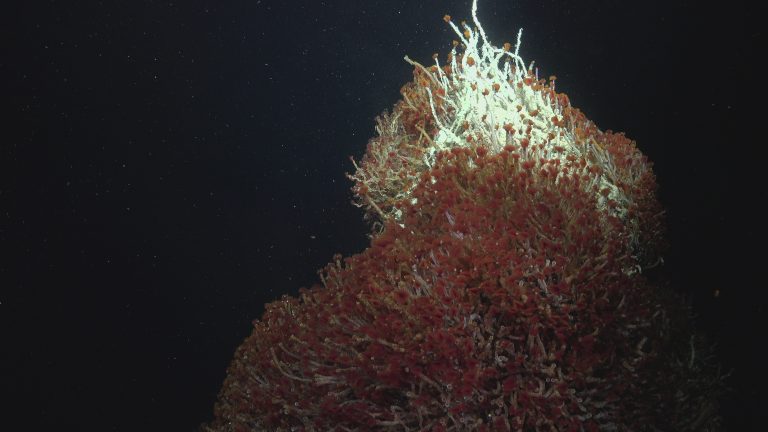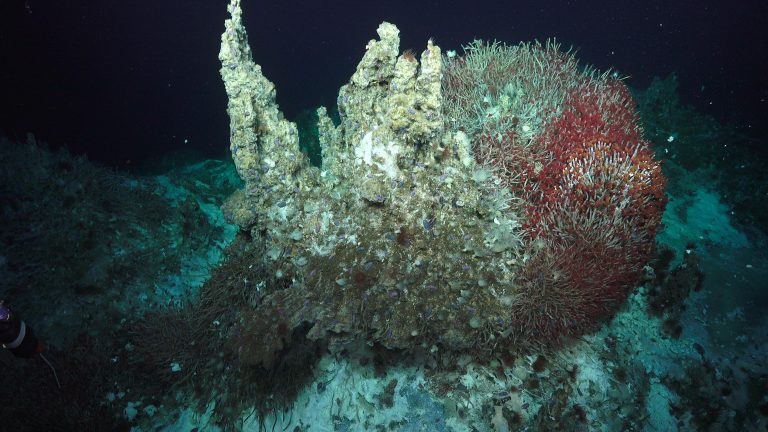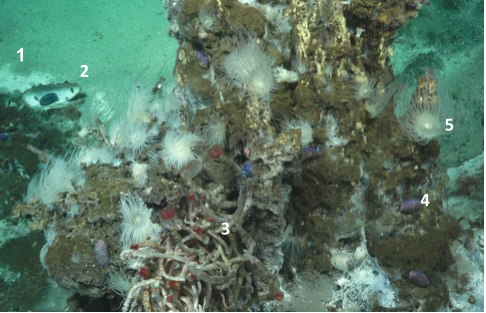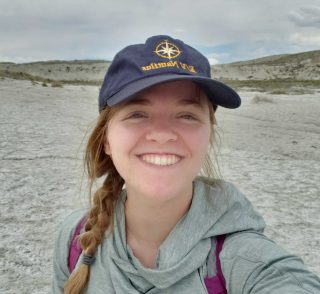Research vessels, like the R/V Falkor, are excellent tools for studying and understanding life on Earth. With state-of-the-art technology armed by a full team of pilots, engineers, crew members, scientists, and our robotic friends (like ROV SuBastian), the deep ocean has never been more accessible. Discoveries are made with every ROV dive. Studying our Earth in this way not only helps us understand life here, but it also helps us understand how life might exist on other planets.

Life – as we know it on Earth – has changed over time and our understanding grows with each new discovery. It was once thought that all life on Earth relied on the sun for energy via photosynthesis. Plants directly make energy from sunlight, and other organisms indirectly gain energy from eating said plants. However, this paradigm changed in 1977 when hydrothermal vents, and the life unexpectedly associated with them, were discovered (1).
Hydrothermal vents are areas in the ocean where heated, geothermally altered seawater escapes through fissures in the ground. It was originally thought that life could not exist here because these vents are too deep for the sunlight to reach. This turns out to not be the case – in fact, hydrothermal vents are ecosystems teeming with life, from microbes to large animals. After careful study, scientists have learned that the vent fluid contains energy sources organisms use to grow and thrive in these extreme environments. Hot hydrothermal fluid rich in chemical energy mixes with cold seawater full of oxidants like oxygen and sulfate, and creates gradients that organisms use to create energy through a process called chemosynthesis. The microorganisms found on hydrothermal vents (from the domains Bacteria and Archaea) are the true champions, as they use a full spectrum of chemicals provided in the vent environment and can survive at the highest temperature extremes currently known for all life (2). Many of the larger animals survive in this environment by forming symbioses with these microorganisms (stay tuned for a blog post from symbiosis expert Dr. Shana Goffredi) The knowledge that life is possible through chemosynthesis expands our conception of how life exists on Earth. We now know that sunlight is not needed for life to thrive here. Questions still remain though, like who lives here and how do they survive in these extreme environments?

Pescadero Basin is one example of a hydrothermal vent system that scientists, such as the ones onboard this expedition, are actively studying. Life is very abundant here in many different forms. White microbial mats cover the seafloor and chimneys where hot fluid is actively flowing out, and animals like clams (Archivesica) and tube worms (Oasisia) have colonized the sediment and rocks (3). Specimens are collected during ROV dives to study in the lab. New species have been found in the Pescadero Basin that is not present anywhere else on Earth(4), and we have discovered new symbiotic associations between organisms where they work together to help each other survive(5).

One of the most amazing things about hydrothermal vents is that they may not be unique to Earth. Discoveries of ocean worlds within our solar system hint at the potential for hydrothermal vent systems on moons including Enceladus (a moon of Saturn) and Europa a (moon of Jupiter) (6). Studying hydrothermal vent systems and microbial extremophiles in places like the S. Pescadero Basin provides a valuable Earth based analog to help inform the parameters of habitability of life as we know it. If hydrothermal vent systems exist on distant moons with the appropriate mix of oxidants and reduced chemical energy, then perhaps these systems can fuel similar life-supporting processes- a question that will continue to motivate future astrobiologists for decades to come. References:
- Karl, D.M., Wirsen, C.O. and Jannasch, H.W., 1980. Deep-sea primary production at the Galapagos hydrothermal vents. Science, 207(4437), pp.1345-1347.
- Takai, K., Nakamura, K., Toki, T., Tsunogai, U., Miyazaki, M. and Miyazaki, J., Hirayama 421 H, Nakagawa S, Nunoura T, Horikoshi K. 2008. Cell proliferation at, 122, pp.10949-10954.
- Michel, A., Wankel, S., Beaulieu, S., Soule, S.A., Mullineaux, L., Coleman, D., Escobar Briones, E., Gaytán-Caballero, A., McDermott, J., Mills, S. and Speth, D., 2018. Biogeochemical Exploration of the Pescadero Basin Vents. Oceanography, 31(1), pp.42-43.
- Hatch, A.S., Liew, H., Hourdez, S. and Rouse, G.W., 2020. Hungry scale worms: Phylogenetics of Peinaleopolynoe (Polynoidae, Annelida), with four new species. ZooKeys, 932, p.27.
- Goffredi, S.K., Motooka, C., Fike, D.A., Gusmão, L.C., Tilic, E., Rouse, G.W. and Rodríguez, E., 2021. Mixotrophic chemosynthesis in a deep-sea anemone from hydrothermal vents in the Pescadero Basin, Gulf of California. BMC biology, 19(1), pp.1-18.
- Barge, L.M. and White, L.M., 2017. Experimentally testing hydrothermal vent origin of life on Enceladus and other icy/ocean worlds. Astrobiology, 17(9), pp.820-833.
Comprender la vida a través de las fuentes hidrotermales
Los barcos de investigación, como el R/V Falkor, son excelentes herramientas para estudiar y comprender la vida en la Tierra. Con una tecnología de vanguardia armada por un equipo completo de pilotos, ingenieros, miembros de la tripulación, científicos y nuestros amigos robóticos (como el ROV SuBastian), el océano profundo nunca ha sido más accesible. Con cada inmersión del ROV se hacen descubrimientos. Estudiar nuestra Tierra de esta manera no sólo nos ayuda a comprender la vida aquí, sino también a entender cómo podría existir la vida en otros planetas.

La vida tal y como la conocemos en este planeta ha cambiado con el tiempo y nuestra comprensión aumenta con cada nuevo descubrimiento. Antes se pensaba que toda la vida en la Tierra dependía del sol para obtener energía mediante la fotosíntesis. Las plantas obtienen energía directamente de la luz solar y otros organismos obtienen energía indirectamente al comer dichas plantas. Sin embargo, este paradigma cambió en 1977, cuando se descubrieron las fuentes hidrotermales y la vida inesperadamente asociada a ellas (1).
Las fuentes hidrotermales son zonas del océano donde el agua de mar calentada y alterada geotérmicamente escapa a través de fisuras en el suelo. En un principio se pensó que la vida no podía existir aquí porque estos respiraderos son demasiado profundos para que llegue la luz del sol. Pero no es así: las fuentes hidrotermales son ecosistemas repletos de vida, desde microbios hasta grandes animales. Tras un cuidadoso estudio, los científicos han descubierto que el fluido de las fumarolas contiene fuentes de energía que los organismos utilizan para crecer y prosperar en estos entornos extremos. El fluido hidrotermal caliente, rico en energía química, se mezcla con el agua de mar fría, llena de oxidantes como el oxígeno y el sulfato, y crea gradientes que los organismos utilizan para crear energía mediante un proceso llamado quimiosíntesis. Los microorganismos que se encuentran en los respiraderos hidrotermales (de los dominios Bacteria y Archaea) son los verdaderos campeones, ya que utilizan todo el espectro de sustancias químicas que proporciona el entorno de los respiraderos y pueden sobrevivir a las temperaturas extremas más altas que se conocen actualmente para toda la vida (2). Muchos de los animales más grandes sobreviven en este entorno formando simbiosis con estos microorganismos (permanezca atento a la entrada del blog de la Dra. Shana Goffredi, experta en simbiosis). El conocimiento de que la vida es posible a través de la quimiosíntesis amplía nuestra concepción de cómo existe la vida en la Tierra. Ahora sabemos que la luz solar no es necesaria para que la vida prospere aquí. Sin embargo, aún quedan preguntas como ¿quién vive aquí y cómo sobrevive en estos entornos extremos?

La cuenca Pescadero es un ejemplo de sistema de respiraderos hidrotermales que los científicos, como los de esta expedición, están estudiando activamente. La vida es muy abundante aquí en muchas formas diferentes. Tapetes microbianos blancos cubren el fondo marino y las chimeneas por las que fluye activamente el fluido caliente, y animales como las almejas (Archivesica) y los gusanos tubulares (Oasisia) han colonizado el sedimento y las rocas (3). Los especímenes se recogen durante las inmersiones con ROV para estudiarlos en el laboratorio. Se han encontrado nuevas especies en la cuenca del Pescadero que no están presentes en ningún otro lugar de la Tierra(4), y hemos descubierto nuevas asociaciones simbióticas entre organismos en las que colaboran para ayudarse mutuamente a sobrevivir (5).

Una de las cosas más sorprendentes de los respiraderos hidrotermales es que puede que no sean exclusivos de la Tierra. Los descubrimientos de mundos oceánicos dentro de nuestro sistema solar apuntan a la posibilidad de que existan sistemas de respiraderos hidrotermales en lunas como Encélado (una luna de Saturno) y Europa a (luna de Júpiter) (6). El estudio de los sistemas de respiraderos hidrotermales y de los microbios extremófilos en lugares como la cuenca del Sur de Pescadero proporciona un valioso análogo terrestre para ayudar a informar sobre los parámetros de habitabilidad de la vida tal y como la conocemos. Si existen sistemas de respiraderos hidrotermales en lunas lejanas con la combinación adecuada de oxidantes y energía química reducida, entonces quizás estos sistemas puedan alimentar procesos similares de apoyo a la vida, una cuestión que seguirá motivando a los futuros astrobiólogos durante las próximas décadas.
References:
- Karl, D.M., Wirsen, C.O. and Jannasch, H.W., 1980. Deep-sea primary production at the Galapagos hydrothermal vents. Science, 207(4437), pp.1345-1347.
- Takai, K., Nakamura, K., Toki, T., Tsunogai, U., Miyazaki, M. and Miyazaki, J., Hirayama 421 H, Nakagawa S, Nunoura T, Horikoshi K. 2008. Cell proliferation at, 122, pp.10949-10954.
- Michel, A., Wankel, S., Beaulieu, S., Soule, S.A., Mullineaux, L., Coleman, D., Escobar Briones, E., Gaytán-Caballero, A., McDermott, J., Mills, S. and Speth, D., 2018. Biogeochemical Exploration of the Pescadero Basin Vents. Oceanography, 31(1), pp.42-43.
- Hatch, A.S., Liew, H., Hourdez, S. and Rouse, G.W., 2020. Hungry scale worms: Phylogenetics of Peinaleopolynoe (Polynoidae, Annelida), with four new species. ZooKeys, 932, p.27.
- Goffredi, S.K., Motooka, C., Fike, D.A., Gusmão, L.C., Tilic, E., Rouse, G.W. and Rodríguez, E., 2021. Mixotrophic chemosynthesis in a deep-sea anemone from hydrothermal vents in the Pescadero Basin, Gulf of California. BMC biology, 19(1), pp.1-18.
- Barge, L.M. and White, L.M., 2017. Experimentally testing hydrothermal vent origin of life on Enceladus and other icy/ocean worlds. Astrobiology, 17(9), pp.820-833.

